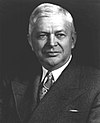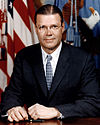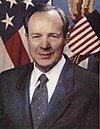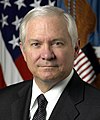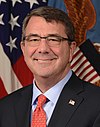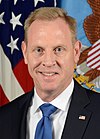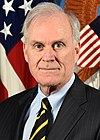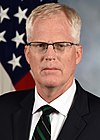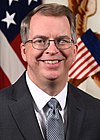United States Secretary of Defense
| United States Secretary of Defense | |
|---|---|
 Seal of the department[1] | |
 | |
since January 22, 2021 | |
| United States Department of Defense Office of the Secretary of Defense | |
| Style | Mr. Secretary (informal) The Honorable(formal) |
| Abbreviation | SecDef |
| Member of | Cabinet National Security Council |
| Reports to | President of the United States |
| Seat | The Pentagon,Arlington County,Virginia |
| Appointer | ThePresident withSenateadvice and consent |
| Term length | No fixed term |
| Constituting instrument | 10 U.S.C.§ 113 |
| Precursor | Secretary of War Secretary of the Navy |
| Formation | September 17, 1947 |
| First holder | James Forrestal |
| Succession | Sixth[3] |
| Deputy | Deputy Secretary of Defense |
| Salary | Executive Schedule, level I[4] |
| Website | defense.gov |
TheUnited States secretary of defense(SecDef) is the head of theUnited States Department of Defense,theexecutive departmentof theU.S. Armed Forces,and is a high-ranking member of thefederal cabinet.[5][6][7]The secretary of defense's position of command and authority over the military is second only to that of thepresident of the United States,who is thecommander-in-chief.This position corresponds to what is generally known as adefense ministerin many other countries.[8]The secretary of defense is appointed by the president with theadvice and consentof theSenate,and is by custom a member of the Cabinet and by law a member of theNational Security Council.[9]
To ensurecivilian control of the military,U.S. law provides that the secretary of defense cannot have served as an active-dutycommissioned officerin the military in the preceding seven years except forgeneralsandadmirals,who cannot have served on active duty within ten years. Congress can grant waivers in such cases.[10]
Subject only to the orders of the president, the secretary of defense is in thechain of commandand exercisescommand and control,for both operational and administrative purposes, over all service branches administered by the Department of Defense – theArmy,Marine Corps,Navy,Air Force,andSpace Force– as well as theCoast Guardwhen its command and control is transferred to the Department of Defense.[11][12][13][14][15]Only the secretary of defense (or the president or Congress) can authorize the transfer of operational control of forces between the three military departments (Department of the Army,the Navy,andthe Air Force) and the elevenUnified Combatant Commands.[11]Because the secretary of defense is vested with legal powers that exceed those of anycommissioned officer,and is second only to the president in the military hierarchy, its incumbent has sometimes unofficially been referred to as "deputycommander-in-chief".[16][17][18]Thechairman of the Joint Chiefs of Staffis the principal military adviser to the secretary of defense and the president; while the chairman may assist the secretary and president in their command functions, the chairman is not in the chain of command.[19]
Thesecretary of state,thesecretary of the treasury,the secretary of defense, and theattorney generalare generally regarded as the four most important (and are officially the four most senior and oldest) cabinet officials because of the size and importance of their respective departments.[20]
The current secretary of defense is retiredgeneralLloyd Austin,who is the firstAfrican Americanto serve in the position.[21]
History

An Army, Navy, and Marine Corps were established in 1775, in concurrence with theAmerican Revolution.TheWar Department,headed by thesecretary of war,was created byAct of Congressin 1789 and was responsible for both the Army and Navy until the founding of a separateDepartment of the Navyin 1798.

Based on the experiences ofWorld War II,proposals were soon made on how to more effectively manage the large combined military establishment. The Army generally favored centralization while the Navy had institutional preferences for decentralization and the status quo. The resultingNational Security Act of 1947was largely a compromise between these divergent viewpoints. It renamed theDepartment of WartheDepartment of the Army,and added both it and theDepartment of the Navyto a newly establishedNational Military Establishment(NME). The Act also separated theArmy Air Forcesfrom the Army to become its own branch of service, theUnited States Air Force.
A new title was coined by the Act for the head of the NME: Secretary of Defense. At first, each of the service secretaries maintained cabinet status. The first secretary of defense,James Forrestal,who in his previous capacity as thesecretary of the Navyhad opposed the creation of the new position, found it difficult to exercise authority over the other branches with the limited powers his office had at the time. To address this and other problems, the National Security Act was amended in 1949 to further consolidate the national defense structure in order to reduceinterservice rivalry,directly subordinate thesecretaries of the Army,the Navy and theAir Forceto the secretary of defense in the chain of command, and rename the National Military Establishment as the Department of Defense, making it oneExecutive Department.The position of thedeputy secretary of defense,the number two position in the department, was also created at this time.
The general trend since 1949 has been to further centralize management in the Department of Defense, elevating the status and authorities of civilianOSDappointees and defense-wide organizations at the expense of the military departments and the services within them. The last major revision of the statutory framework concerning the position was done in theGoldwater–Nichols Department of Defense Reorganization Act of 1986.In particular, it elevated the status of joint service for commissioned officers, making it in practice a requirement before appointments to general officer and flag officer grades could be made.
As the secretary of defense is a civilian position intended to be independent of the active-duty leadership, a secretary is required to have been retired from service for at least seven (originally ten) years unless a waiver is approved by Congress.[22]Since the creation of the position in 1947, such a waiver has been approved only three times, for Army generalGeorge Marshallin 1950, Marine Corps GeneralJim Mattisin 2017, and retired Army generalLloyd Austinin 2021.[23][24]
Powers and functions
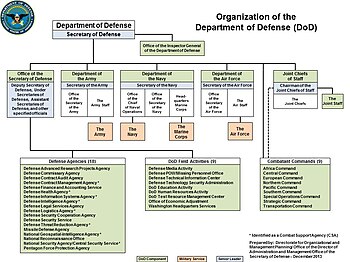
The secretary of defense, appointed by thepresidentwith the advice and consent of theSenate,is by federal law (10 U.S.C.§ 113) the head of the Department of Defense, "the principal assistant to the President in all matters relating to Department of Defense", and has "authority, direction and control over the Department of Defense". Because theConstitutionvests all military authority inCongressand the president, the statutory authority of the secretary of defense is derived from their constitutional authorities. Since it is impractical for either Congress or the president to participate in every piece of Department of Defense affairs, the secretary of defense and the secretary's subordinate officials generally exercise military authority.
As the head of DoD, all officials, employees and service members are "under" the secretary of defense. Some of those high-ranking officials, civil and military (outside of OSD and the Joint Staff) are: thesecretary of the Army,secretary of the Navy,andsecretary of the Air Force,Army chief of staff,commandant of the Marine Corps,chief of naval operations,Air Force chief of staff,chief of space operations,andchief of the National Guard Bureauand the combatant commanders of theCombatant Commands.All these high-ranking positions, civil and military, require Senate confirmation.
The Department of Defense is composed of theOffice of the Secretary of Defense(OSD), theJoint Chiefs of Staff(JCS) and theJoint Staff(JS),Office of the Inspector General(DODIG), theCombatant Commands,the Military Departments (Department of the Army(DA),Department of the Navy(DON) &Department of the Air Force(DAF)), theDefense Agencies and DoD Field Activities,theNational Guard Bureau(NGB), and such other offices, agencies, activities, organizations, and commands established or designated by law, or by the president or by the secretary of defense.
Department of Defense Directive 5100.01 describes the organizational relationships within the department and is the foundational issuance for delineating the major functions of the department. The latest version, signed by former secretary of defenseRobert Gatesin December 2010, is the first major re-write since 1987.[25][26]
Office of the Secretary of Defense
The secretary's principally civilian staff element is called theOffice of the Secretary of Defense(OSD) and is composed of thedeputy secretary of defense(DEPSECDEF) and six under secretaries of defense in the fields ofacquisition & sustainment,research & engineering,comptroller/chief financial officer,intelligence,personnel & readiness,andpolicy;severalassistant secretaries of defense;other directors and the staffs under them.
The name of the principally military staff organization, organized under the chairman of the Joint Chiefs of Staff, is theJoint Staff(JS).
Awards and decorations
TheDefense Distinguished Service Medal(DDSM), theDefense Superior Service Medal(DSSM), theDefense Meritorious Service Medal(DMSM), theJoint Service Commendation Medal(JSCM) and theJoint Service Achievement Medal(JSAM) are awarded, to military personnel for service in joint duty assignments, in the name of the secretary of defense. In addition, there is theJoint Meritorious Unit Award(JMUA), which is the only ribbon (as in non-medal) and unit award issued to joint DoD activities, also issued in the name of the secretary of defense.
The DDSM is analogous to the distinguished services medals issued by the military departments (i.e.Army Distinguished Service Medal,Navy Distinguished Service Medal&Air Force Distinguished Service Medal), the DSSM corresponds to theLegion of Merit,the DMSM to theMeritorious Service Medal,the JSCM to the service commendation medals, and the JSAM to the achievement medals issued by the services. While the approval authority for DSSM, DMSM, JSCM, JSAM and JMUA is delegated to inferior DoD officials: the DDSM can be awarded only by the secretary of defense.
Recommendations for theMedal of Honor(MOH), formally endorsed in writing by the secretary of the military department concerned and thechairman of the Joint Chiefs of Staff,are processed through theunder secretary of defense for personnel and readiness,and such recommendations be must approved by the secretary of defense before it can be handed over to the president, who is the final approval authority for the MOH, although it is awarded in the name ofCongress.
The secretary of defense, with the concurrence of thesecretary of state,is the approval authority for the acceptance and wear ofNATOmedals issued by thesecretary general of NATOand offered to theU.S. permanent representative to NATOin recognition of U.S. servicemembers who meet the eligibility criteria specified by NATO.[27]
Congressional committees
As the head of the department, the secretary of defense is the chief witness for the congressional committees with oversight responsibilities over the Department of Defense. The most important committees, with respect to the entire department, are the two authorizing committees, theSenate Armed Services Committee(SASC) and theHouse Armed Services Committee(HASC), and the two appropriations committees, theSenate Appropriations Committeeand theHouse Appropriations Committee.
For the DoD intelligence programs theSenate Select Committee on Intelligenceand theHouse Permanent Select Committee on Intelligencehave the principal oversight role.
National Security Council
The secretary of defense is a statutory member of theNational Security Council.[28]As one of the principals, the secretary along with thevice president,secretary of state and theassistant to the president for national security affairsparticipates in biweekly Principals Committee (PC) meetings, preparing and coordinating issues before they are brought before full NSC sessions chaired by the president.
Role in the military justice system
The secretary is one of only five or six civilians – the others being the president, the three "service secretaries" (thesecretary of the Army,secretary of the Navy,andsecretary of the Air Force), and thesecretary of homeland security(when theUnited States Coast Guardis under theUnited States Department of Homeland Securityand has not been transferred to theDepartment of the Navyunder the Department of Defense) – authorized to act asconvening authorityin themilitary justice systemforGeneral Courts-Martial(10 U.S.C.§ 822:article 22,UCMJ), Special Courts-Martial (10 U.S.C.§ 823:article 23, UCMJ), and Summary Courts-Martial (10 U.S.C.§ 824:article 24 UCMJ).
Salary
Secretary of Defense is aLevel I position in the Executive Schedule,[4]thus earning a salary ofUS$221,400, as of January 2021.[29]
List of secretaries of defense
The longest-serving secretary of defense isRobert McNamara,who served for a total of 7years, 39 days. Combining his two non-sequential services as the secretary of defense, the second-longest serving isDonald Rumsfeld,who served just ten days fewer than McNamara. The second-longest unbroken tenure was Caspar Weinberger's, at 6years, 306 days.
The shortest-serving secretary of defense isElliot Richardson,who served 114 days and then was appointedU.S. attorney generalamid theresignationsof theWatergate Scandal.(This is not countingdeputy secretaries of defenseWilliam P. ClementsandWilliam Howard Taft IV,who each served a few weeks as temporary/acting secretary of defense).
For precursors to this position prior to the establishment of the Department of Defense, see the lists ofsecretaries of the Navyandsecretaries of warprior to 1947.
- Parties
Democratic Republican Independent/ Unknown
- Status
| No. | Portrait | Secretary of Defense | Took office | Left office | Time in office | Party | State of residence | President serving under |
Ref. |
|---|---|---|---|---|---|---|---|---|---|
| 1 | James Forrestal (1892–1949) | September 17, 1947 | March 28, 1949 | 1 year, 192 days | Democratic | New York | Harry S. Truman(D) | [30] | |
| 2 | Louis A. Johnson (1891–1966) | March 28, 1949 | September 19, 1950 | 1 year, 175 days | Democratic | West Virginia | Harry S. Truman(D) | [31] | |
| 3 | George C. Marshall (1880–1959) | September 21, 1950 | September 12, 1951 | 356 days | Independent | Pennsylvania | Harry S. Truman(D) | [32] | |
| 4 | Robert A. Lovett (1895–1986) | September 17, 1951 | January 20, 1953 | 1 year, 125 days | Republican | New York | Harry S. Truman(D) | [33] | |
| 5 | Charles Erwin Wilson (1890–1961) | January 28, 1953 | October 8, 1957 | 4 years, 253 days | Republican | Michigan | Dwight D. Eisenhower(R) | [34] | |
| 6 | Neil H. McElroy (1904–1972) | October 9, 1957 | December 1, 1959 | 2 years, 53 days | Republican | Ohio | Dwight D. Eisenhower(R) | [35] | |
| 7 | Thomas S. Gates Jr. (1906–1983) | December 2, 1959 | January 20, 1961 | 1 year, 49 days | Republican | Pennsylvania | Dwight D. Eisenhower(R) | [36] | |
| 8 | Robert McNamara (1916–2009) | January 21, 1961 | February 29, 1968 | 7 years, 39 days | Republican | Michigan | John F. Kennedy(D) Lyndon B. Johnson(D) | [37] | |
| 9 | Clark Clifford (1906–1998) | March 1, 1968 | January 20, 1969 | 325 days | Democratic | Maryland | Lyndon B. Johnson(D) | [38] | |
| 10 | Melvin R. Laird (1922–2016) | January 22, 1969 | January 29, 1973 | 4 years, 7 days | Republican | Wisconsin | Richard Nixon(R) | [39] | |
| 11 | Elliot Richardson (1920–1999) | January 30, 1973 | May 24, 1973 | 114 days | Republican | Massachusetts | Richard Nixon(R) | [40] | |
| – | Bill Clements (1917–2011) Acting | May 24, 1973 | July 2, 1973 | 39 days | Republican | Texas | Richard Nixon(R) | [41] | |
| 12 | James R. Schlesinger (1929–2014) | July 2, 1973 | November 19, 1975 | 2 years, 140 days | Republican | Virginia | Richard Nixon(R) Gerald Ford(R) | [42] | |
| 13 | Donald Rumsfeld (1932–2021) | November 20, 1975 | January 20, 1977 | 1 year, 61 days | Republican | Illinois | Gerald Ford(R) | [43] | |
| 14 | Harold Brown (1927–2019) | January 20, 1977 | January 20, 1981 | 4 years, 0 days | Democratic | California | Jimmy Carter(D) | [44] | |
| 15 | Caspar Weinberger (1917–2006) | January 21, 1981 | November 23, 1987 | 6 years, 306 days | Republican | California | Ronald Reagan(R) | [45] | |
| 16 | Frank Carlucci (1930–2018) | November 23, 1987 | January 20, 1989 | 1 year, 58 days | Republican | Virginia | Ronald Reagan(R) | [46] | |
| – | William Howard Taft IV (born 1945) Acting | January 20, 1989 | March 21, 1989 | 60 days | Republican | Ohio | George H. W. Bush(R) | [47] | |
| 17 | Dick Cheney (born 1941) | March 21, 1989 | January 20, 1993 | 3 years, 305 days | Republican | Wyoming | George H. W. Bush(R) | [48] | |
| 18 | Leslie Aspin (1938–1995) | January 20, 1993[49][50] | February 3, 1994 | 1 year, 14 days | Democratic | Wisconsin | Bill Clinton(D) | [51] | |
| 19 | William Perry (born 1927) | February 3, 1994 | January 23, 1997[52]/ January 24, 1997[49][53] | 2 years, 356 days | Democratic | Pennsylvania | Bill Clinton(D) | . | |
| 20 | William Cohen (born 1940) | January 24, 1997 | January 20, 2001 | 3 years, 362 days | Republican | Maine | Bill Clinton(D) | [54] | |
| 21 | Donald Rumsfeld (1932–2021) | January 20, 2001 | December 18, 2006 | 5 years, 332 days (7 years, 29 days total) | Republican | Illinois | George W. Bush(R) | [55] | |
| 22 | Robert Gates (born 1943) | December 18, 2006 | June 30, 2011[56]/ July 1, 2011[49] | 4 years, 194 days | Republican | Texas | George W. Bush(R) Barack Obama(D) | . | |
| 23 | Leon Panetta (born 1938) | July 1, 2011 | February 26, 2013 | 1 year, 240 days | Democratic | California | Barack Obama(D) | [57] | |
| 24 | Chuck Hagel (born 1946) | February 27, 2013 | February 17, 2015 | 1 year, 355 days | Republican | Nebraska | Barack Obama(D) | [58] | |
| 25 | Ash Carter (1954–2022) | February 17, 2015 | January 20, 2017 | 1 year, 338 days | Democratic | Massachusetts | Barack Obama(D) | [59][49] | |
| 26 | Jim Mattis (born 1950) | January 20, 2017 | January 1, 2019 | 1 year, 345 days | Independent | Washington | Donald Trump(R) | [60] | |
| – | Patrick M. Shanahan (born 1962) Acting | January 1, 2019 | June 23, 2019 | 173 days | Independent | Washington | Donald Trump(R) | [61] | |
| – | Mark Esper (born 1964) Acting | June 24, 2019 | July 15, 2019 | 21 days | Republican | Virginia | Donald Trump(R) | [62] | |
| – | Richard V. Spencer (born 1954) Acting | July 15, 2019 | July 23, 2019 | 8 days | Republican | Wyoming | Donald Trump(R) | [63] | |
| 27 | Mark Esper (born 1964) | July 23, 2019 | November 9, 2020 | 1 year, 109 days | Republican | Virginia | Donald Trump(R) | [62] | |
| – | Christopher C. Miller (born 1965) Acting | November 9, 2020 | January 20, 2021 | 72 days | Republican | Iowa | Donald Trump(R) | [62] | |
| – | David Norquist (born 1966) Acting | January 20, 2021 | January 22, 2021 | 2 days | Republican | Massachusetts | Joe Biden(D) | [64] | |
| 28 | Lloyd Austin (born 1953) | January 22, 2021 | Incumbent | 3 years, 256 days | Independent | Georgia | Joe Biden(D) | [65] |
Succession
Presidential succession
The secretary of defense is sixth in thepresidential line of succession,following thesecretary of the treasuryand preceding theattorney general.[66]
Secretary succession
On December 10, 2020, President Donald Trump modified the order of succession for the office of Secretary of Defense in Executive Order 13963. The order of succession is:[67]
Notes
- ^According to the Executive Order precedence states – in layman’s terms – that appointees designated the same succession number are determined by the order in which the date they were appointed (senate confirmed) to their position. However appointees designated the same succession number and have the same appointment (senate confirmed) date shall be determined by the order in which they have taken the oath to serve in that office.
- ^Congress disestablished the CMO position with the passage of theWilliam M. (Mac) Thornberry National Defense Authorization Act for Fiscal Year 2021effective 1 January 2021.[68]
See also
- Base Realignment and Closure Commission
- Boeing E-4
- Challenge coin
- Combat Exclusion Policy
- Commission to Assess the Ballistic Missile Threat to the United States
- Continuity of Operations Plan
- CONPLAN 8022-02
- Defense Policy Board Advisory Committee
- Defense Support of Civil authorities
- Department of Defense Directive 2310
- Designated survivor
- Emergency Action Message
- Global Command and Control System
- Gold Codes
- Hamdan v. Rumsfeld
- Joint Worldwide Intelligence Communications System
- Key West Agreement
- McCarran Internal Security Act
- Military Commissions Act of 2006
- Military operation plan
- National Command Authority (United States)
- National Industrial Security Program
- National Security Strategy (United States)
- Office of the Secretary of Defense Identification Badge
- Packard Commission
- Permissive Action Link
- Presidential Successor Support System
- Quadrennial Defense Review
- Rules of engagement
- Secretary of Defense Employer Support Freedom Award
- Single Integrated Operational Plan
- State secrets privilege
- Stop-loss policy
- Two-man rule
- Unconventional warfare (United States Department of Defense doctrine)
- United States Foreign Military Financing
- US Commission on National Security/21st Century
References
Citations
- ^Trask & Goldberg:p. 177.
- ^"Positional Colors for the Department of Defense".United States Army Institute of Heraldry.Archivedfrom the original on September 16, 2023.RetrievedSeptember 16,2023.
- ^"3 U.S. Code § 19 – Vacancy in offices of both President and Vice President; officers eligible to act".Archivedfrom the original on December 26, 2018.RetrievedFebruary 4,2017.
- ^ab5 U.S.C.§ 5312
- ^10 U.S.C.§ 113.
- ^DoDD 5100.1:Enclosure 2: a
- ^5 U.S.C.§ 101.
- ^"NATO – member countries".NATO.Archivedfrom the original on May 17, 2013.RetrievedJanuary 4,2012.
- ^50 U.S.C.§ 402.
- ^See10 U.S.C.§ 113.TheNational Security Act of 1947originally required an interval of ten years after relief from active duty, which was reduced to seven years by Sec. 903(a) of the2008 National Defense Authorization Act.In 1950 Congress passed special legislation (Pub. Law 81-788) to allowGeorge C. Marshallto serve as Secretary of Defense while remaining a commissioned officer on the active list of the Army (Army regulations kept allfive-star generalson active duty for life), but warned:
It is hereby expressed as the intent of the Congress that the authority granted by this Act is not to be construed as approval by the Congress of continuing appointments of military men to the office of Secretary of Defense in the future. It is hereby expressed as the sense of the Congress that after General Marshall leaves the office of Secretary of Defense, no additional appointments of military men to that office shall be approved.
Defenselink bioArchivedNovember 18, 2008, at theWayback Machine,Retrieved February 8, 2010; andMarshall Foundation bioArchivedSeptember 27, 2011, at theWayback Machine,Retrieved February 8, 2010.
- ^ab10 U.S.C.§ 162
- ^Joint Publication 1:II-9, II-10 & II-11.
- ^10 U.S.C.§ 3011
- ^10 U.S.C.§ 5011
- ^10 U.S.C.§ 8011
- ^Trask & Goldberg:pp.11 & 52
- ^Cohen:p.231.
- ^Korb, Lawrence J.; Ogden, Pete (October 31, 2006)."Rumsfeld's Management Failures".Center for American Progress.Archivedfrom the original on October 22, 2017.RetrievedJanuary 6,2012.
- ^10 U.S.C.§ 152
- ^Cabinets and Counselors: The President and the Executive Branch(1997).Congressional Quarterly.p. 87.
- ^"Senate confirms Biden's Defense Secretary Lloyd Austin, the first Black Pentagon chief".Fox News.January 22, 2021.Archivedfrom the original on January 22, 2021.RetrievedJanuary 22,2021.
- ^Peters, Heidi M. (December 1, 2016)."Waiver of Statutory Qualifications Relating to Prior Military Service of the Secretary of Defense".UNT Digital Library.Archivedfrom the original on December 9, 2020.RetrievedDecember 8,2020.
- ^"Why Generals Need Congressional Waivers To Become Defense Secretary".NPR.org.Archivedfrom the original on December 10, 2020.RetrievedDecember 8,2020.
- ^Youssef, Nancy A. (January 21, 2021)."Lloyd Austin Receives Waiver Allowing Him to Become Defense Chief".The Wall Street Journal.Archivedfrom the original on January 22, 2021.RetrievedJanuary 21,2021.
- ^Department of Defense Directive 5100.01 Functions of the Department of Defense and Its Major Components
- ^DoDD 5100.1:p.1.
- ^DoDM 1348.33, Vol 3:p.39 (Enclosure 3)
- ^50 U.S.C.§ 402
- ^"Salary Table No. 2021-EX Rates of Basic Pay for the Executive Schedule (EX)"(PDF).Archived(PDF)from the original on January 23, 2021.
- ^"James V. Forrestal – Harry S. Truman Administration".Office of the Secretary of Defense – Historical Office.Archivedfrom the original on August 14, 2017.RetrievedFebruary 7,2017.
- ^"Louis A. Johnson – Harry S. Truman Administration".Office of the Secretary of Defense – Historical Office.Archivedfrom the original on January 4, 2017.RetrievedFebruary 7,2017.
- ^"George C. Marshall – Harry S. Truman Administration".Office of the Secretary of Defense – Historical Office.Archivedfrom the original on February 7, 2017.RetrievedFebruary 7,2017.
- ^"Robert A. Lovett – Harry S. Truman Administration".Office of the Secretary of Defense – Historical Office.Archivedfrom the original on May 16, 2022.RetrievedFebruary 7,2017.
- ^"Charles E. Wilson – Dwight D. Eisenhower Administration".Office of the Secretary of Defense – Historical Office.
- ^"Neil H. McElroy – Dwight D. Eisenhower Administration".Office of the Secretary of Defense – Historical Office.Archivedfrom the original on February 8, 2017.RetrievedFebruary 7,2017.
- ^"Thomas S. Gates, Jr. – Dwight D. Eisenhower Administration".Office of the Secretary of Defense – Historical Office.
- ^"Robert S. McNamara – John F. Kennedy / Lyndon Johnson Administration".Office of the Secretary of Defense – Historical Office.Archivedfrom the original on February 7, 2017.RetrievedFebruary 7,2017.
- ^"Clark M. Gifford – Lyndon Johnson Administration".Office of the Secretary of Defense – Historical Office.Archivedfrom the original on February 13, 2017.RetrievedFebruary 7,2017.
- ^"Melvin R. Laird – Richard Nixon Administration".Office of the Secretary of Defense – Historical Office.Archivedfrom the original on February 8, 2017.RetrievedFebruary 7,2017.
- ^"Elliot L. Richardson – Richard Nixon Administration".Office of the Secretary of Defense – Historical Office.Archivedfrom the original on February 7, 2017.RetrievedFebruary 7,2017.
- ^Cantwell, Gerald T. (1997).Citizen Airmen: A History of the Air Force Reserve 1946–1994.DIANE Publishing. p. 252.ISBN9781428991620.
In June 1973, Representative O. C. Fisher complained to William P. Clements, Jr., acting Secretary of Defense, that the authority, responsibility, and, consequently, effectiveness of the chiefs of the various reserve components seemed to be eroding.
- ^"James R. Schlesinger – Richard Nixon / Gerald Ford Administration".Office of the Secretary of Defense – Historical Office.Archivedfrom the original on February 8, 2017.RetrievedFebruary 7,2017.
- ^"Donald H. Rumsfeld – Gerald Ford Administration".Office of the Secretary of Defense – Historical Office.Archivedfrom the original on February 8, 2017.RetrievedFebruary 7,2017.
- ^"Harold Brown – James Carter Administration".Office of the Secretary of Defense – Historical Office.Archivedfrom the original on November 22, 2018.RetrievedFebruary 7,2017.
- ^"Caspar W. Weinberger – Ronald Reagan Administration".Office of the Secretary of Defense – Historical Office.Archivedfrom the original on October 22, 2023.RetrievedFebruary 7,2017.
- ^"Frank C. Carlucci – Ronald Reagan Administration".Office of the Secretary of Defense – Historical Office.Archivedfrom the original on February 7, 2017.RetrievedFebruary 7,2017.
- ^"II. Secretaries of Defense".Washington Headquarters Services – Pentagon Digital Library.p. 9. Archived fromthe original(PDF)on February 11, 2017.RetrievedFebruary 8,2017.
(Deputy Secretary of Defense William H. Taft served as acting secretary of defense from 20 January 1989 until 21 March 1989).
- ^"Richard B. Cheney – George H.W. Bush Administration".Office of the Secretary of Defense – Historical Office.Archivedfrom the original on June 14, 2019.RetrievedFebruary 7,2017.
- ^abcdDepartment of Defense Key Officials September 1947 – February 2019
- ^"Les Aspin Serves One Year As Defense Secretary".Archivedfrom the original on December 8, 2023.RetrievedMarch 18,2019.
- ^"Leslie Aspin – William J. Clinton Administration".Office of the Secretary of Defense – Historical Office.Archivedfrom the original on July 8, 2023.RetrievedFebruary 7,2017.
- ^"William J. Perry – William J. Clinton Administration".Office of the Secretary of Defense – Historical Office.Archivedfrom the original on April 22, 2021.RetrievedFebruary 7,2017.
- ^"II. Secretaries of Defense".Washington Headquarters Services – Pentagon Digital Library.p. 10. Archived fromthe original(PDF)on February 11, 2017.RetrievedFebruary 8,2017.
Sworn in as secretary of defense on 3 February 1994 and served until 24 January 1997.
- ^"William S. Cohen – William J. Clinton Administration".Office of the Secretary of Defense – Historical Office.Archivedfrom the original on September 19, 2023.RetrievedFebruary 7,2017.
- ^"Donald H. Rumsfeld – George W. Bush Administration".Office of the Secretary of Defense – Historical Office.Archivedfrom the original on February 7, 2017.RetrievedFebruary 7,2017.
- ^"Robert M. Gates – George W. Bush / Barack Obama Administration".Office of the Secretary of Defense – Historical Office.Archivedfrom the original on February 7, 2017.RetrievedFebruary 7,2017.
- ^"Leon E. Panetta – Barack Obama Administration".Office of the Secretary of Defense – Historical Office.Archivedfrom the original on February 7, 2017.RetrievedFebruary 7,2017.
- ^"Chuck Hagel – Barack Obama Administration".Office of the Secretary of Defense – Historical Office.Archivedfrom the original on February 25, 2017.RetrievedFebruary 7,2017.
- ^"Ashton B. Carter – Barack Obama Administration".Office of the Secretary of Defense – Historical Office.Archivedfrom the original on February 7, 2017.RetrievedFebruary 7,2017.
- ^"James N. Mattis – Donald Trump Administration".Office of the Secretary of Defense – Historical Office.Archivedfrom the original on February 12, 2017.RetrievedFebruary 7,2017.
- ^"PN583 – Patrick M. Shanahan – Department of Defense".Congress.gov.Library of Congress. July 18, 2017.Archivedfrom the original on January 7, 2019.RetrievedJanuary 1,2019.
- ^abc"Dr. Mark T. Esper – Acting Secretary of Defense".United States Department of Defense. June 24, 2019.Archivedfrom the original on August 2, 2019.RetrievedJune 24,2019.
- ^"Letter from Acting Secretary of Defense Richard V. Spencer to Pentagon".USNI News.July 15, 2019.Archivedfrom the original on July 23, 2019.RetrievedJuly 16,2019.
- ^"Trump administration official Norquist sworn in as acting Pentagon chief".The Hill.January 20, 2021.Archivedfrom the original on January 20, 2021.RetrievedJanuary 20,2021.
- ^"Senate confirms Lloyd Austin to be first Black defense secretary".cnn.com.January 22, 2021.Archivedfrom the original on January 22, 2021.RetrievedJanuary 22,2021.
- ^3 U.S.C.§ 19.
- ^"Executive Order on Providing an Order of Succession within the Department of Defense".December 10, 2020.Archivedfrom the original on December 15, 2020.RetrievedJanuary 9,2022.
- ^"Department of Defense Implements Section 901 of the FY2021 National Defense Authorization Act".RetrievedJanuary 28,2021.
General sources
Federal law
Directives, regulations and manuals
- Department of Defense Directive 5100.1: Functions of the Department of Defense and Its Major Components(PDF).Washington, D.C.:U.S. Department of Defense.December 21, 2010. Archived fromthe original(PDF)on May 25, 2017.RetrievedAugust 30,2011.
- Department of Defense Manual 1348.33, Volume 1: Manual of Military Decorations and Awards: General Information, Medal of Honor, and Defense/Joint Decorations and Awards(PDF).Washington, D.C.:U.S. Department of Defense.March 7, 2013. Archived fromthe original(PDF)on March 22, 2011.
- Department of Defense Manual 1348.33, Volume 2: Manual of Military Decorations and Awards: General Information, Medal of Honor, and Defense/Joint Decorations and Awards(PDF).Washington, D.C.:U.S. Department of Defense.May 31, 2013. Archived fromthe original(PDF)on March 22, 2011.
- Department of Defense Manual 1348.33, Volume 3: Manual of Military Decorations and Awards: General Information, Medal of Honor, and Defense/Joint Decorations and Awards(PDF).Washington, D.C.:U.S. Department of Defense.November 23, 2010. Archived fromthe original(PDF)on February 26, 2013.RetrievedJune 14,2013.
- Joint Publication 1 – Doctrine for the Armed Forces of the United States(PDF).Joint Publications. Washington, D.C.:U.S. Department of Defense.March 25, 2013. Archived fromthe original(PDF)on October 27, 2011.
- Joint Publication 1-04 – Legal Support to Military Operations(PDF).Joint Publications. Washington, D.C.:U.S. Department of Defense.August 17, 2011. Archived fromthe original(PDF)on March 13, 2013.RetrievedJune 14,2013.
Further reading
- Cohen, Eliot A.(2003).Supreme Command: Soldiers, Statesmen and Leadership in Wartime.New York:Anchor Books.ISBN978-1-4000-3404-8.
- Cole, Alice C.; Goldberg, Alfred; Tucker, Samuel A.; et al., eds. (1978).The Department of Defense: Documents on Establishment and Organization 1944–1978(PDF).Washington, D.C.: Historical Office,Office of the Secretary of Defense/U.S. Government Printing Office.Archived fromthe original(PDF)on July 14, 2014.
- Department of Defense Key Officials September 1947 – February 2019(PDF).Washington, D.C.: Historical Office,Office of the Secretary of Defense.January 30, 2019.
- Huntington, Samuel P.(1957).The Soldier and the State.Cambridge, Massachusetts: The Belknap Press of Harvard University Press.ISBN0-674-81736-2.
- King, Archibald (1960) [1949].Command of the Army(PDF).Military Affairs. Charlottesville, Virginia:The Judge Advocate General's School, U.S. Army.Archived(PDF)from the original on July 31, 2008.
- Mahan, Erin R., and Jeffrey A. Larsen, eds. (2012)."Evolution of the Secretary of Defense in the Era of Massive Retaliation: Charles Wilson, Neil McElroy, and Thomas Gates, 1953–1961",Cold War Foreign Policy Series: Special Study3 (September 2012), vii–41.
- Stevenson, Charles A. (2006).SECDEF: The Nearly Impossible Job of Secretary of Defense.Dulles, Virginia: Potomac Books.ISBN1-57488-794-7.
- Trask, Roger R.; Goldberg, Alfred (1997).The Department of Defense 1997–1947: Organization and Leaders(PDF).Washington, D.C.: Historical Office,Office of the Secretary of Defense/U.S. Government Printing Office.ISBN0-16-049163-0.Archived fromthe original(PDF)on July 14, 2014.
Primary historical sources
- Cheney, Dick;Cheney, Liz(2011).In My Time: A Personal and Political Memoir.New York:Simon & Schuster.ISBN978-1-4391-7619-1.
- Rumsfeld, Donald(2011).Known and Unknown: A Memoir.New York:Sentinel.ISBN978-1-59523-067-6.
Online sources
- "Department of Defense Directive 5100.01 Functions of the Department of Defense and Its Major Components".Office of the Secretary Defense, Director of Administration and Management, Directorate for Organizational & Management Planning. Archived fromthe originalon May 7, 2013.RetrievedJune 13,2013.






